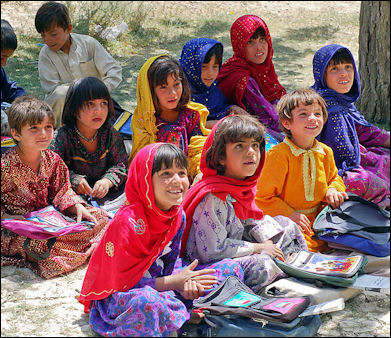MARRIAGE AND LOVE

Long-term studies conducted by the PAIRS project have found that: 1) couples most in love when they get married are most likely to get divorced; 2) the chemical reaction that characterizes the intense love that some people use to chose their partner fades “to neutrality” in two or three years; and 3) wife murderers tend be strong believers in romantic love.
Some researchers can more accurately predict whether a couple will stay together than the couple themselves. The determination is often based less on things like fighting and more on everyday things like asking your spouse how his or her day was. Some studies have found for women, a man’s body odor is helpful in finding a good genetic match.
Psychologist David M Bass did a study involving 10,000 men and women in 37 different cultures. In almost every society he found that women are more likely up put economic considerations at the top of the list in choosing a mate.
Poor villagers generally get married at a very young age. It is not unusual for couples to have families with four or five children before they reach their mid twenties. Unmarried people in their 20s tend to live with their parents rather than on their own. It is not uncommon for well liked foreigners who visit a village to be offered a teen-age bride.
Newlyweds usually get married in the autumn after the harvest. In the spring and summer, there is too much other work to do. In towns most weddings are held in a rented-out wedding parlors, not churches, temples or mosquez. Instead of exchanging rings the couples sign a registry book.
Divorce laws generally favor the husband’s family. In many places a divorced woman may keep her children until they are seven, then she has to turn them over to the husbands family.
Arranged Marriages and Multiple Wives
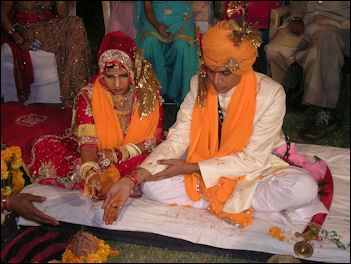
Hindu marriage ceremony Marriages are often arranged by parents and families. In some cases the bride and groom meet for the first time on their wedding day. To symbolize the passing of her youth and her separation from her family the bride sometimes breaks her childhood possessions and puts on a crying display at her wedding to let her parents know she'll miss them.
The intent of arranged marriages is to preserve family fortunes, improve the social and economic status of a family with the hope the couple will get along together. Men sometimes buy their brides.
According to 1982 study by two Indian researchers, the level of self-reported love in arranged marriages increased over time until it surpasses the level of self-reported love in marriages in which partners are freely chosen.
There are still places, where men have multiple wives. The custom is often against the law but is often alive in places that are so remote it is difficult to enforce the law. In a study of 1,179 societies, polygamy (men with multiple wives) was 100 times more common than polyandry (women having multiple husbands).
American-style dating is not common. Teenagers meet each other through family friends, clubs and festivals. Urban youth sometimes go to love hotels to have sex. Public displays of affection are frowned upon.
Child Brides Face More Mental Illness
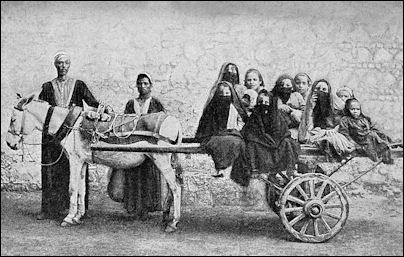
Harem scene Child marriages, more often than not involving girls, are fairly common in some developing countries.
In August 2011, Reuters reported, “Child brides more often face psychiatric disorders than women who marry after they turn 18, according to a study that is the first to try and gauge the mental toll of child marriage, which is already tied to several health problems. So far, most research has focused on child marriages in low- and middle-income nations in Africa and Asia, where it is often rampant. But the report, published in Pediatrics, said that the United States also has a fair share of underage brides. [Source: Reuters August 30, 2011]
Based on a government survey from 2001 and 2002, the study estimated that as many as nine percent of U.S. women took their vows when they were under the age of 18. "Child marriage increases the risk of lifetime and current psychiatric disorders in the United States," wrote Yann Le Stat, at the French National Institute of Health and Medical Research in Paris, and colleagues. "Support for psychiatric vulnerabilities among women married in childhood is required."About 9.4 million women in the United States married at 16 or younger, and 1.7 million were no older than 15, according to the government survey.
Face-to-face interviews with nearly 25,000 women who were at least 18 showed that 53 percent of those who had been child brides had some psychiatric disorder, such as depression or anxiety. That compared to 49 percent of women who married as adults.Women who married under the age of 18 were also more likely to be diagnoses as "nicotine dependent" and with "anti-social personality disorder."The researchers cautioned that their findings don't prove that marrying as a child will necessarily lead to mental illness. Yet most women had been married before they developed mental problems, and the findings couldn't entirely be written off as due to the differences in household incomes, education and other social factors, they added.
Village Families
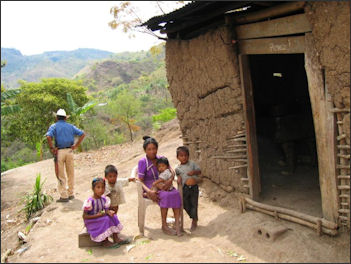
Family in Honduras In the developing world everyone seems related to everyone else and cousins are often encouraged to marry each other to keep farms and orchards in the family.
Many homes are occupied by an "extended family," made up a variety of relatives, not just a "nuclear family" with parents and children. The extended family is the basis of society and exerts a major influence on an individual’s life and decisions.
It is not uncommon for three generations to live in the same house. A typical household consists of a husband, wife, children, grandparents and unmarried brothers and sisters. In large extended families, uncles, aunts, nieces and nephew are often treated with same familiarity as parents and children. If they don’t live in the same house or compound, grandparents, uncles, aunts and cousin often live either next door or in the same neighborhood. Close family friends are often also called grandfather, grandmother, uncle or aunt.
Parents often have the same concerns as parents in the developed world. They want their children to get an education, to be safe and have opportunities they never had. Families have traditionally sent their son away to attend secondary school while the daughters stayed at home under the watchful eyes of their parents.
Families also provide economic and social support in countries that are too poor to provide welfare and unemployment insurance. If one family member has a good job it is not unusual for other members of the family to move in and live off his or her income.
The global market economy has made many traditional family roles obsolete.
Typical Developing World Family
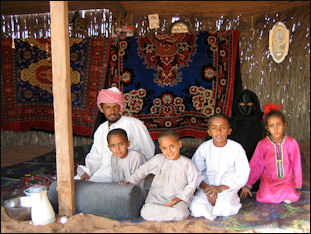
Bedouin family A typical family is made up of a husband, wife, three children and a grandmother. They collectively earn between $1000 and $2000 a year and live in a two room house with a corrugated tin roof, worth a little over a $1000. They have a flush toilet and their most treasured possessions are a small boom box, a radio and a religious painting. They own a few animals, eat grain three meals a day along with maybe eggs for breakfast, and stew for lunch and dinner.
The husband works about 60 hours a week tending his fields and working at some odd job. The wife spends 15 hours a day running the house, caring for her children and hand-washing the family laundry. The husband has had one year of education, and can read and write, and his children spend five hours a day in school.
The family has no savings, medical coverage or social security and their definition of success is simply "staying alive." They have no vehicle: the primary means of transportation are walking or taking a bus. Much of their free time and social life revolves around their church and its activities.
Village Men
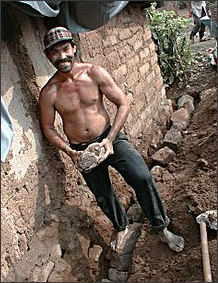
hardworking village man In many village societies men are strong and animated. They are big talkers, and sing and dance with passion and enthusiasm. Men usually hang out with men and women usually hang out with women. Men sometimes buy cigarettes before they buy food for their families.
Men are regarded as the head of the household, the major decision-maker and major breadwinner. Their status and the standing of their family is determined by their success at the roles mentioned above. Inheritance is traditionally transferred from father to oldest son.
Village men have traditionally done the heavy chores such as plowing the fields, clearing the land, planting and harvesting, building homes, hunting, fishing, setting traps, cutting down trees. and doing work that requires the most strength while the women the tended crops.
Since the work of the men is often concentrated into a few weeks they have a lot of free time, which is spent hanging around, gambling or making deals. Often, while women work the men spend much of the time in the tea houses chatting and playing games such as poker, backgammon or dominoes, or sitting around the radio or television tuned into soccer matches or the news.
Many bars, coffee houses, tea houses, and even restaurants are male-only establishments. Women entering these places are received the same way they would if they entered the men's rest room.
Village Children
Village families that can't afford diapers sometimes cut holes in their children's pants or let them wander around naked.
Parks and playgrounds are in short supply and children often hurt themselves playing in the streets.
Schoolgirls in Bamozai, Afghanistan Toys include hoops, push carts, tops, and marbles. Families have little money for toys and amusements so children learn to make things for themselves: small sailboats made from broken sandals and popsicle sticks; soccer balls made from wadded up plastic bags and twine; pull toys made from sardine cans or plastic bottles; and puppets and dolls are made from wood, bamboo and scraps of old clothes. Rocks are often used as toys.
Children take on responsibility early, often tending animals such as buffalo, cows, goats and sheep. When they are five or six rural children begin helping their sibling tend goats and other animals. When they are seven or eight they have enough skill to take care of 20 or so goats.
In poor families, children are often forced to work and earn money rather than attend school. In villages, boys take care of the animals and work in the fields. Girls collect water and grind and thresh grain. Older siblings (especially girls) often help take care of the younger children.
Children who adopted and brought into the United States must meet stringent legal requirements. They and their mothers must undergo DNA testing to make sure the mothers are really the birth mother. The mother must also participate in numerous interviews and sign a final adoption decree. Even with these strict guidelines, United Nations officials estimate that 4 percent of all adopted children come from questionable sources.
Child Poverty and Health in the Developing World
As of 2009, an estimated 1 billion children were still deprived of adequate food, shelter, clean water, and health care according to UNICEF. However great advances have been made reducing the number of deaths among children and getting kids into schools.
An estimated 24,000 children under five die every day of preventable causes such as pneumonia, malaria , measles and malnutrition. Nearly 200 million children are malnourished and 140 million are forced to work. In addition, millions of girl and boys are subjected to sexual violence.
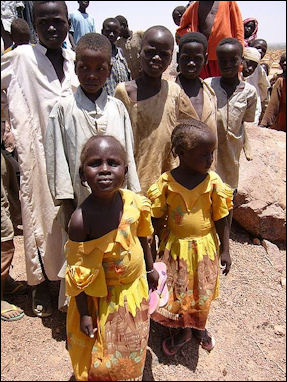
Refugee children in Chad The Convention on the Rights of Children was adopted by the United Nations in 1989. More than 70 countries have the used the treaty to incorporate children’s rights into their national laws. Only two countries have not ratified it: the United States and Somalia.
Baby formula that cost $1.50 a week is often too expensive for many villagers.
About 10.5 million children under five die every year, with 99 percent of them in developing countries, many of them from problems related to lack of clean water, poor access to health care, malnutrition, inadequate immunization and violence.
In developing countries 1 of every 10 babies born dies before reaching the age of 5 (compared to 7 out of 1,000 in Scandinavia). Many young children die before the age of five from treatable diseases like diarrhea. Many are born with a low birth weight, an indicator of maternal malnutrition and predictor of children dying before they are five. Undernutrition remains a root cause of 53 percent of deaths for children under five. Nineteen percent died of pneumonia between 2000 and 2003.
Things are better than they used to be. The number of children under the age of five that died world wide declined from 13 million in 1990 to 9.7 million in 2006.
Aid groups encourage breast-feeding because studies have shown that it produces healthier children. Breast feeding is credited with saving the lives of six million babies a year, but the number could be even higher if more mothers used the method. According to UNICEF: “Only 39 percent of infants in the developing world are exclusively breast fed. Lack of awareness among mothers and lack of support from health workers and communities, is largely to blame.”
Elderly People in Villages

Hutte headman Respect for elders is often the basis for the way society is organized. Older people are respected for their wisdom and most important decisions are not made without consulting them. To pay respects to the older generation, children are often named after their grandparents in a special ceremony.
Old age is supposed to a time when the elderly can kick back and relax after a lifetime of hard work and have their children take care of them. But in many cases old people have been abandoned by their children or have been put in charge of raising grandchildren while children go to the cities to work. Many villages are inhabited almost exclusively by old people. Most of the young families have moved out. In some cases they began leaving as soon as good roads to the village were built and a means leaving became available.
One aging expert told U.S. News and World Report. "The developed world got rich before it got old. In the developing world the trend is reversed."
Image Sources: Wikimedia Commons
Text Sources: New York Times, Washington Post, Los Angeles Times, Times of London, Yomiuri Shimbun, The Guardian, National Geographic, The New Yorker, Time, Newsweek, Reuters, AP, Lonely Planet Guides, Compton’s Encyclopedia and various books and other publications.
Last updated January 2012

